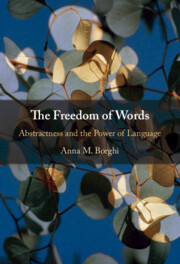Book contents
- The Freedom of Words
- The Freedom of Words
- Copyright page
- Dedication
- Contents
- Figures
- Acknowledgments
- Introduction
- Part I Language and Its Power
- Part II Abstractness and Language
- Chapter 5 Different Varieties of Abstract Concepts
- Chapter 6 Abstractness and Language as a Physical Tool
- Chapter 7 Abstractness and Language as an Inner Tool
- Chapter 8 Abstractness and Language as a Social Tool
- Chapter 9 Conclusion
- Index
- References
Chapter 7 - Abstractness and Language as an Inner Tool
from Part II - Abstractness and Language
Published online by Cambridge University Press: 20 July 2023
- The Freedom of Words
- The Freedom of Words
- Copyright page
- Dedication
- Contents
- Figures
- Acknowledgments
- Introduction
- Part I Language and Its Power
- Part II Abstractness and Language
- Chapter 5 Different Varieties of Abstract Concepts
- Chapter 6 Abstractness and Language as a Physical Tool
- Chapter 7 Abstractness and Language as an Inner Tool
- Chapter 8 Abstractness and Language as a Social Tool
- Chapter 9 Conclusion
- Index
- References
Summary
Chapter 7 shows that abstract concepts are inner/cognitive tools. Inner speech is potent in enhancing our cognition, imagination, and motivation. In this chapter, I propose that we use inner speech more extensively with more abstract concepts, during both their acquisition and use, while monitoring our knowledge during their processing and referring to others to complement and enrich it. I review several studies with children and adults showing that the mouth motor system is more engaged during abstract concept acquisition and elaboration. This mouth activation suggests that language is implicitly activated during abstract language processing. Also, while low numbers engage the hand effector more, the processing of larger numbers might involve language, hence the mouth, more extensively. I overview research on the neural underpinning of abstract concepts, which confirms the importance of linguistic and social neural networks for their representation. Finally, I illustrate studies on abstractness in conditions characterized by impairments in social interaction and inner and overt speech abilities, such as autism, schizophrenia, and aphasia. Overall, the studies reviewed support the idea of a determinant role of language as an inner tool supporting the acquisition and use of abstract concepts.
Keywords
- Type
- Chapter
- Information
- The Freedom of WordsAbstractness and the Power of Language, pp. 209 - 254Publisher: Cambridge University PressPrint publication year: 2023



